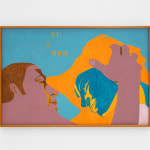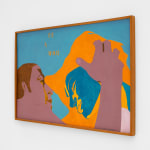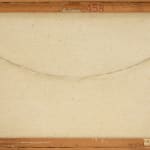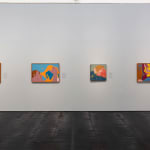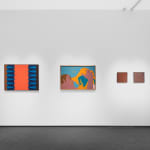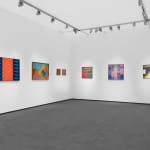Judith Lauand Brazilian, 1922-2022
Até a morte [Until death], 1969
Acrylic on canvas
70 x 105 cm
27 1/2 x 41 3/8 in
27 1/2 x 41 3/8 in
Signed and dated bottom right
Further images
While the status of artists was harshly affected by the censorship and persecution of intellectuals by the military regime installed in 1964, members of Grupo Ruptura continually sought to position...
While the status of artists was harshly affected by the censorship and persecution of intellectuals by the military regime installed in 1964, members of Grupo Ruptura continually sought to position themselves within an international art dialogue. Lauand’s association in the late 1960s with a movement termed ‘Popcreto’ by the São Paulo artists, identifying an exchange between international Pop and local Concretism, reflects her responsiveness to international directions in art. Her figurative and text-based works from this period utilise the wordplay of Concrete poetry and a new visual language of Pop art, offering an avenue to explore themes of gender and political violence.
Até a morte [Until Death] (1969) is an essential example from this period. It incorporates the wordplay of Concrete poetry; the suspended text can be reconfigured into multiple phrases around the words ‘amor [love]’ and ‘morte [death].’ In an image both sinister and passionate, the female figure is radiant, her hair like a flame, held by the strong grip of her male counterpart.
This piece was first exhibited at the 10th São Paulo Biennial (1969), boycotted by many countries opposed to Brazil’s military dictatorship. In choosing to exhibit on this occasion, Lauand positioned herself amongst a younger generation of female artists encouraging conversations on censorship and on the social conditions of women in Latin America. This period of Lauand’s work also reflects a perpetual revision of the visual language of Concretism that continued to define her work throughout her lengthy career.
Até a morte [Until Death] (1969) is an essential example from this period. It incorporates the wordplay of Concrete poetry; the suspended text can be reconfigured into multiple phrases around the words ‘amor [love]’ and ‘morte [death].’ In an image both sinister and passionate, the female figure is radiant, her hair like a flame, held by the strong grip of her male counterpart.
This piece was first exhibited at the 10th São Paulo Biennial (1969), boycotted by many countries opposed to Brazil’s military dictatorship. In choosing to exhibit on this occasion, Lauand positioned herself amongst a younger generation of female artists encouraging conversations on censorship and on the social conditions of women in Latin America. This period of Lauand’s work also reflects a perpetual revision of the visual language of Concretism that continued to define her work throughout her lengthy career.
Provenance
Acquired from the artistPrivate collection, São Paulo
Exhibitions
X Bienal de São Paulo, Brazil (1969)Judith Lauand: 50 Anos de Pintura, Galeria Berenice Arvani, São Paulo, Brazil (2007)
Judith Lauand: Brazilian Modernist, 1950s-2000s, Driscoll Babcock Galleries, New York, US (2014)
Judith Lauand: Desvio Concreto, Museu de Arte de São Paulo Assis Chateaubriand (MASP), São Paulo, Brazil (2022-23)
Publications
Judith Lauand: Brazilian Modernist, 1950s-2000s, exhibition catalogue (New York: Driscoll Babcock Galleries, 2014), p.16, pl. 23.Judith Lauand: Desvio Concreto, exhibition catalogue (São Paulo: Museu de Arte de São Paulo Assis Chateaubriand, 2022), pl. 190.
![Judith Lauand, Até a morte [Until death], 1969](https://artlogic-res.cloudinary.com/w_1600,h_1600,c_limit,f_auto,fl_lossy,q_auto/artlogicstorage/cbprojects/images/view/d87311045a9fa9719a05713d7c9c0c50j.jpg)
![Judith Lauand, Até a morte [Until death], 1969](https://artlogic-res.cloudinary.com/w_1600,h_1600,c_limit,f_auto,fl_lossy,q_auto/artlogicstorage/cbprojects/images/view/6baab166bad4247ca5dfa08fa64fbb7fj.jpg)
![Judith Lauand, Até a morte [Until death], 1969](https://artlogic-res.cloudinary.com/w_1600,h_1600,c_limit,f_auto,fl_lossy,q_auto/artlogicstorage/cbprojects/images/view/962d9f6e33cb18f0c2f9bbaa85163383j.jpg)
![Judith Lauand, Até a morte [Until death], 1969](https://artlogic-res.cloudinary.com/w_1600,h_1600,c_limit,f_auto,fl_lossy,q_auto/artlogicstorage/cbprojects/images/view/340a3a14243b8513b343971c8fae40f0j.jpg)
![Judith Lauand, Até a morte [Until death], 1969](https://artlogic-res.cloudinary.com/w_1600,h_1600,c_limit,f_auto,fl_lossy,q_auto/artlogicstorage/cbprojects/images/view/38cad570b0e6044fdc7f6094499dfbdej.jpg)
![Judith Lauand, Até a morte [Until death], 1969](https://artlogic-res.cloudinary.com/w_1600,h_1600,c_limit,f_auto,fl_lossy,q_auto/artlogicstorage/cbprojects/images/view/a3a9c49db1e2e8fce771070c69f9520ej.jpg)
